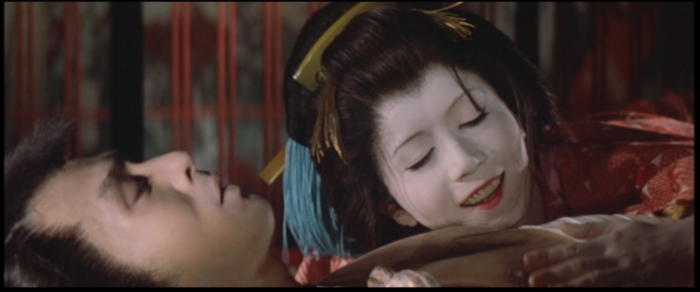Imagine that the counter-culture of the late 1960s and early 1970s was transposed to the last decades of the Tokugawa Shogunate. That is the concept behind the The Scandalous Adventures of Buraikan, the last of five cinematic collaborations between Shuji Terayama and the celebrated film director, Masahiro Shinoda.
In 1970, Shinoda was at the peak of his powers, having won global critical acclaim with Double Suicide (1969), his post-modern take on the bunraku puppet-theatre, which featured some actors from Terayama’s experimental theatre troupe. Terayama himself was to make his debut as a film director with Throw Away Your Books in 1971 and follow up with the highly accomplished To Die in the Country in 1972.
Some of the themes he developed in those films are visible in the script-writing he did for Buraikan (literally, “rascal”).
The story was originally a kabuki play, first performed in 1881. The writer, Mokuami Kawatake, was noted for his depiction of lovable rogues and thieves who tweak the noses of the authorities. While keeping most of the trickster scenes and some of the dialogue, Terayama adds a lot of contemporary allusions and private concerns of his own.
Naojiro, the besotted lover of the original, becomes a man-boy with a severe mother complex- just like Terayama himself. The swordsman Kaneko becomes a nihilistic terrorist who wants to kill all those in power – rather like the psychotic fringe of the radical left. The trickster Kouchiyama becomes a politically savvy operator with an agenda of his own. The fresh-faced actor Sanmon turns out to be a dedicated agitator who studied Wang Yangming Confucian theory under Heihachiro Oshio, the Bakunin of his era.
On the other hand, the middle-aged, establishment-supporting merchant, Morita, is appalled by the hedonism of the younger generation. “They should be studying instead of spending their time on girls and booze, gambling, mixed bathing and so on,” he grumbles. “No wonder Lord Mizuno is so worried. At this rate our national spirit will be stolen by Western countries like Oroosha and Eggriland.”
Morita is particularly upset by the fact that the luminous geisha that he is obsessed with prefers to bestow her affections on the young and penniless Naojiro.
The entire sub-plot about the violent rebellion of the outsiders and marginalized classes was created by Terayama and Shinoda and would have had obvious resonances with the contemporary audience. Just one year earlier, the student left had staged a bloody incursion into the Diet in a failed attempt to block the renewal of the U.S. Japan Security Treaty.
The period in which the action takes place is the early 1840s, when the austerity drive known as the Tempo Reforms was being instituted by the Shogun’s right-hand man, Tadakuni Mizuno. He appears in the film as a puritanical sourpuss played by Hiroshi Akutagawa, son of the famed novelist. In the end – beyond the time-frame of the film – his attempt to impose political correctness on Edo and ban “evil luxury” failed and he was fired.
Terayama was explicit about the parallels. “At the time, books about courtesans, kabuki, fireworks and other entertainments of the townspeople were being banned and there seemed to be similarities with the underground art of today, with the resistance against repression seeking liberation.”
The film-makers reinforced the counter-cultural parallel visually by filling the interiors with the Robert Crumb-like art-work of “Ekin of Tosa,” a highly transgressional painter who was rediscovered in the 1960s after a century of obscurity. His pictures include scenes of decapitations, hara-kiri, farting contests, ghosts and ghouls and all kinds of grotesquerie.
Terayama wrote this in the brochure accompanying the film’s release –
“What we were aiming for was not an aesthetic of beauty, but an aesthetic of ugliness. The world of Ekin of Tosa, or a peeling screen in a temple depicting the tortures of hell. Rape, menaces, robbery, arson, murder and, to bring it all together, a riot and rebellion with a cruel ending. We wanted to show in film the indestructible truth that people change, but the world itself does not.”
Despite the presence of stars like Tatsuya Nakadai and Tetsuro Tanba, The Scandalous Adventures of Buraikan is not one of Shinoda’s most esteemed or internationally recognized works, perhaps because it requires some understanding of Japanese history and politics. The visuals are sumptuous, the acting top-class and the message has not dated. People may change individually, but the world – which is simply a reflection of human nature – does not and can not.
In the words of Lord Mizuno, “Power will never perish. It will just be replaced.” Or, in early 1970s terms – “Meet the new boss, same as the old boss…”



